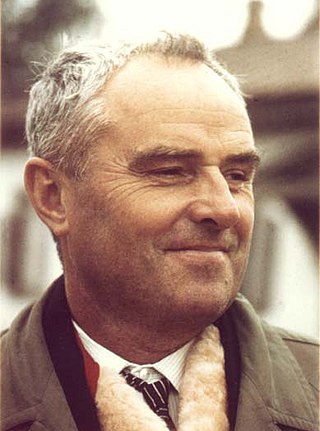
Computer science is the study of computation, information, and automation. Computer science spans theoretical disciplines to applied disciplines. Though more often considered an academic discipline, computer science is closely related to computer programming.

An academic discipline or field of study is a branch of knowledge, taught and researched as part of higher education. A scholar's discipline is commonly defined by the university faculties and learned societies to which they belong and the academic journals in which they publish research.

Prof Sergei Lvovich Sobolev FRSE was a Soviet mathematician working in mathematical analysis and partial differential equations.

The Bauman Moscow State Technical University, sometimes colloquially referred as the Bauman School or Baumanka (Бауманка), is a public technical university (polytechnic) located in Moscow, Russia. Bauman University offers B.S., M.S & PhD degrees in various engineering fields and applied sciences. In 2023, US News & World Report ranked it #1,758 in the world.

Victor Mikhailovich Glushkov was a Soviet mathematician, the founding father of information technology in the Soviet Union and one of the founding fathers of Soviet cybernetics.
The Central Economic Mathematical Institute of the Russian Academy of Sciences is an economic research institute located in Moscow. It focuses on economic theory, mathematical economics and econometrics. The CEMI was established in 1963 as an institute of the Academy of Sciences of the USSR, superseding the Laboratory of Economics and Mathematical Methods which had been founded by Vasily Sergeevich Nemchinov in 1958. In 1964 a branch of the institute was created in Tallinn, and in 1966 a Leningrad branch was established.

Simon Kuznets Kharkiv National University of Economics is the largest economic higher educational and research institution in the eastern part of Ukraine. The university was established in 1912 and was named after American economist Simon Kuznets, its noted alumnus, in 2013.

Stuart Anspach Umpleby is an American cybernetician and professor in the Department of Management and Director of the Research Program in Social and Organizational Learning in the School of Business at the George Washington University.

Alexey Grigoryevich Ivakhnenko was a Soviet and Ukrainian mathematician most famous for developing the group method of data handling (GMDH), a method of inductive statistical learning, for which he is sometimes referred to as the "Father of deep learning".
Alexey Andreyevich Lyapunov was a Soviet mathematician and an early pioneer of computer science. One of the founders of Soviet cybernetics, Lyapunov was member of the Academy of Sciences of the Soviet Union and a specialist in the fields of real function theory, mathematical problems of cybernetics, set theory, programming theory, mathematical linguistics, and mathematical biology.

Arkady Ivanovich Melua is the general director and editor-in-chief of the scientific publishing house, Humanistica.
Howard George Willis Ware, popularly known as Willis Howard Ware was an American computer pioneer who co-developed the IAS machine that laid down the blueprint of the modern day computer in the late 20th century. He was also a pioneer of privacy rights, social critic of technology policy, and a founder in the field of computer security.
OGAS was a Soviet project to create a nationwide information network. The project began in 1962 but was denied necessary funding in 1970. It was one of a series of socialist attempts to create a nationwide cybernetic network.
Cybernetics in the Soviet Union had its own particular characteristics, as the study of cybernetics came into contact with the dominant scientific ideologies of the Soviet Union and the nation's economic and political reforms: from the unmitigated anti-Americanist criticism of cybernetics in the early 1950s; its legitimization after Stalin's death and up to 1961; its total saturation of Soviet academia in the 1960s; and its eventual decline through the 1970s and 1980s.
"The Main Features of Cybernetics" was a key text which led to the emergence of cybernetics in the Soviet Union, published in July–August 1955 volume of the state philosophical organ, Voprosy filosofii, No. 4. pp. 136–148. The article was attributed to three significant soviet scientists, Sergei Sobolev, Alexey Lyapunov, and Anatoly Kitov and, for the first time, presented the tenets of cybernetics to a Soviet audience. Alongside the article "What is Cybernetics" by Ernst Kolman, published in the same volume, Benjamin Peters has considered this article to have "set the stage for the revolution of cybernetics in the Soviet Union".

Akademset, or All-Union Academic network — was a computer network for providing digital connection of scientific and civil institutions across the USSR, that was established in 1978. In fact, it was a Soviet forerunner to the Internet and had a connection with ARPANET and other western analogues using the common digital standard called X.25. After dissolution of the Soviet Union it was re-created under the name ROKSON (РОКСОН), and nowadays its extant components may be considered as a local area network within the Runet and the Internet.

Pskov State University is a public university in the Pskov Region of Russia. It is one of the 33 flagship universities in Russia. Pskov SU was established in 2010 by several other educational institutions in the region.
Razdan is a family of general-purpose digital electronic computers created from 1958–1965 at the Yerevan Computer Research and Development Institute (YerNIIMM). The computer has a semiconductor element base, that is, it belongs to computers of the second generation.











